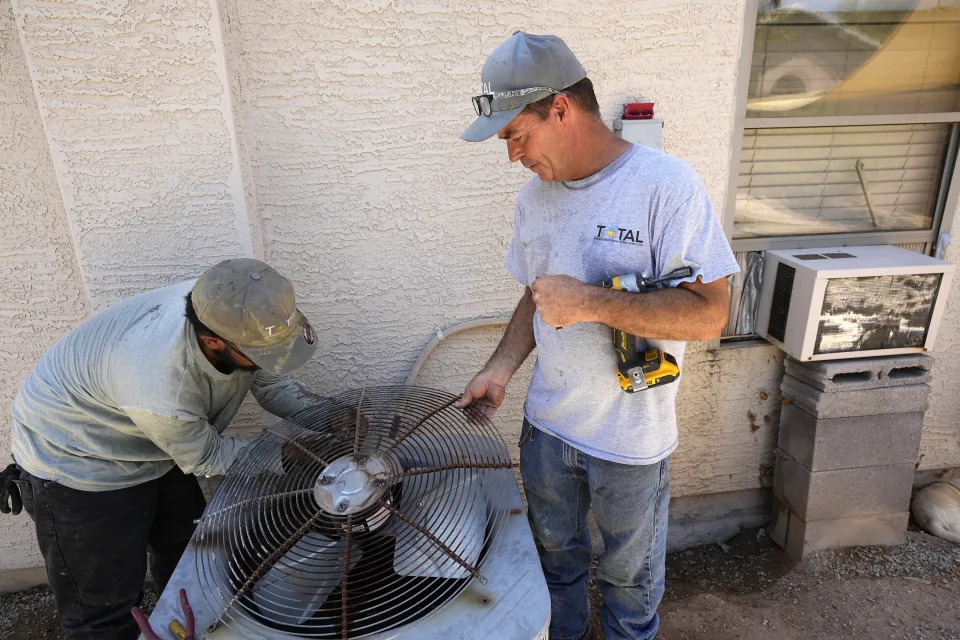The New York Times
Texas’ Harsh New Border Tactics Are Injuring Migrants
Edgar Sandoval, Jay Root and J. David Goodman – July 20, 2023

For more than two years, Gov. Greg Abbott of Texas has pursued an increasingly aggressive approach to the border, sending thousands of National Guard troops and police officers to patrol the Rio Grande and testing the legal limits of state action on immigration.
But in recent weeks, Texas law enforcement officials have taken those tactics much further, embarking on what the state has called a “hold-the-line” operation, according to interviews with state officials and documents reviewed by The New York Times. They have fortified the riverbanks with additional concertina wire, denied water to some migrants, shouted at others to return to Mexico and, in some cases, deliberately failed to alert federal Border Patrol agents who might assist arriving groups in coming ashore and making asylum claims, the review found.
The increasingly brutal, go-it-alone approach has alarmed people inside the U.S. Border Patrol and the Texas Department of Public Safety, the agency chiefly responsible for pursuing the governor’s border policies. Several Texas officers have lodged internal complaints and voiced opposition.
The reality of those tactics in one area of the border, around the small city of Eagle Pass, was detailed in an email by one state police medic, who described exhausted migrants being cut up by razor wire, a teenager breaking his leg to escape the barriers and officers being directed to withhold water from migrants struggling in the perilous heat. The actions described in the email drew broad condemnation from Texas Democrats in Congress and from the White House after the email was reported by the Houston Chronicle.
“If they are true, it is abhorrent. It is despicable. It is dangerous,” said White House press secretary, Karine Jean-Pierre, referring to the reports. “We’re talking about the bedrock values of who we are as a country.” The Justice Department said Wednesday that it was assessing the situation.
But the objections within the Texas Department of Public Safety extended far beyond a single medic: At least three other officers working around Eagle Pass, a main arrival point for migrants who are crossing illegally, have expressed their outrage and misgivings to higher-ups about the actions they have seen, according to internal correspondence and interviews with state officials briefed on the border response.
And it was not only officers describing the harshness of the new tactics. In several interviews with the Times in Eagle Pass, about two hours southwest of San Antonio, migrants nursing wounds said they had encountered phalanxes of law enforcement officers along banks of the United States that were newly bristling with barbed wire, some of it underwater.
“They kept yelling at us, ‘Go back, go back!’” said Reyna Gloria Dominguez, 42, who arrived in Eagle Pass from Honduras in a wheelchair. “We said, ‘We can’t.’ My son told them, ‘She needs help. She’s hurt.’”
Similar scenes have been playing out elsewhere along the border, including in the Texas city of Brownsville, near the mouth of the Rio Grande, where state police officers have been standing guard at crossing points behind two layers of concertina wire.
The increasing aggressiveness has created international tension with Mexico because, in addition to placing concertina wire, Texas also deployed a 1,000-foot floating barrier of buoys into the Rio Grande in Eagle Pass this month. Mexican officials have said the barrier may have violated international treaties and could encroach on Mexican territory.
Texas officials have blamed the Biden administration for allowing a chaotic situation on the border. They said the buoy barrier and concertina wire were designed to deter people from risking a dangerous swim across the Rio Grande and direct them to safe, official border-crossing stations.
“No orders or directions have been given under Operation Lone Star that would compromise the lives of those attempting to cross the border illegally,” Abbott said in a joint statement with top officials from the Texas Department of Public Safety and the Texas Military Department, using the name of the state operation.
The new Texas tactics have frayed relations between state and federal law enforcement agencies that have long worked together to monitor the border.
In a memo to the Texas DPS last month, Border Patrol officials in the Eagle Pass area raised concern that the concertina wire placed along the water by Texas officials was creating new hazards for migrants as well as for federal border agents.
At the same time, state police supervisors have been directed by their own superiors not to alert Border Patrol when encountering groups of migrants, but rather to handle the situation themselves, according to a departmental text message addressed to sergeants, obtained by the Times.
“Can you please push out a message to your troopers,” the text read, referring to those stationed in a city-owned park by the international bridge in Eagle Pass. “They are NOT to call BP when they see a group approaching or already on the bank.” Officers were instead directed to make arrests for criminal trespassing, an element of Operation Lone Star.
The text message, which was sent last week and has not been previously reported, also directed officers to tell migrants to “go back to Mexico” and to cross the border at one of the international bridges.
Many of the migrants who arrived in Eagle Pass after passing through the treacherous new gantlet were left shaken, and some were injured.
Gleyders Durant, 27, a migrant from Venezuela, peeled off bandages on his right foot to reveal several wounds. He said that as he crossed the river on Friday and stepped onto U.S. soil — his 3-year-old son on his shoulders and his wife following them — he felt a sharp pain. Blood gushed through one of his tennis shoes.
“That’s when I realized that I had stepped on a stretch of wire hidden under dark waters,” he said. Panicked, he extended his arms and carried his wife over it. “It was hidden, under the water.”
Nearby, in a respite center in Eagle Pass, another migrant from Venezuela, Marjorie Escobar, 32, described a harrowing encounter Saturday between her group of about 20 people, including children as young as 4, and several law enforcement agents in Texas.
As some in her group threw inflatables and blankets over the concertina wire to avoid injury, she said, the agents began yelling, “Go back to Mexico!” and “If you cross, we are going to arrest and charge you.”
Then, she said, an agent wearing a brown uniform and a cowboy hat who appeared to be a Texas state trooper roughly pulled a blanket off the barrier as people were climbing over it. The abrupt maneuver caused a young woman to hit her face on a spike, leaving a gash on her forehead, Escobar recalled. She said several of the agents stood still for several minutes, until an officer wearing what looked like a soldier’s uniform offered help to the wounded woman.
State officials did not immediately respond to a request for comment on the incident.
“I was still in the river, about to jump over, when I saw what that agent did and was horrified,” she said of the officer in the cowboy hat. “She was crying, saying, ‘Help me, help me.’”
Because of the increased number of migrants being taken to the lone hospital in Eagle Pass, residents have often been waiting up to eight hours to receive medical care, said Mayor Rolando Salinas Jr. “I support legal migration and orderly law enforcement,” he said in an interview Wednesday. “What I am against is the use of tactics that hurt people.”
The tactics by Texas appear to have intensified in the lead-up to the lifting in late May of Title 42, a public health policy imposed during the coronavirus pandemic that allowed federal agents to rapidly expel most arriving migrants.
The Department of Public Safety has defended its approach and said officers were providing assistance to migrants in medical distress. “There is not a directive or policy that instructs troopers to withhold water from migrants or push them back into the river,” an agency spokesperson, Travis Considine, said.
At the same time, Considine said, officers, who have been directed to keep migrants from entering and to instruct them to return to Mexico, are given some discretion in how they carry out those orders.
“If there are women and children who are asking for water, they’re getting water,” he said. “A group of 30 adult males comes, and they’re begging for water. I’m not going to say there are not troopers saying, ‘We’re not going to give you water.’” He said that if the migrants did not seem to be in distress, troopers might tell them to go get water in Mexico.
The four officers who raised concerns said there were explicit orders to deny water to migrants and to tell them to go back to Mexico. Three said they had been told by supervisors that troopers were not to inform the Border Patrol when migrants were in the water or at the Texas riverbank.
One of the officers, Trooper Nicholas Wingate, was a medic. In an email to supervisors July 3, he said numerous migrants, including a pregnant woman, had gotten tangled in the razor wire. He said the woman, 19, was “doubled over” and “in obvious pain, stuck in the casualty wire.” A 4-year-old girl who attempted to cross was “pressed back by Texas Guard soldiers due to orders given to them,” he wrote in the email.
With temperatures soaring past 100 degrees that day, the girl passed out and became “unresponsive,” Wingate wrote. She was taken away by emergency medical workers.
Wingate also described seeing a father with lacerations on his leg after extricating his child from what he called a “barrel trap,” a plastic barrel floating in the water with concertina wire surrounding it. “I believe we have stepped over the line into the inhumane,” he wrote.
Considine said the agency did not deploy “barrel traps.” But he said it was possible that a barrel that had been wrapped in concertina wire in one part of the river to hold it in place had floated away in rising waters, though he said that the agency had not confirmed that was the case.
On the question of coordinating with Border Patrol, Considine said officers did not alert Border Patrol when arresting migrants for criminal trespassing. He said the number of such arrests had increased recently in and around Eagle Pass.
But federal law entitles people who enter the United States, even unlawfully, to claim asylum by stating that they faced persecution in their home country.
It is not clear how many migrants have died while crossing the border in recent weeks.
The river is always treacherous, and four people, including an infant, drowned this month in the span of a few days. According to the sheriff’s office in Maverick County, which includes Eagle Pass, 26 migrants have drowned so far in 2023. There were 77 migrant drownings in the county in all of last year.
For some local officials, the hardened border was sending the wrong message.
“Seeing barbed wire on the bank of the river, it doesn’t look good for the USA,” said Sheriff Tom Schmerber of Maverick County. “We’re used to seeing all that in communist countries. Now we have them here in Texas.”
“It’s kind of like a black eye. And it’s not working anyway,” he added. “It’s not stopping the immigrants.”








































